Want to start laser crafting but don’t have the space or budget for a larger laser? Check out Glowforge Spark™! This mini but mighty laser is perfect for beginners who want to give laser crafting a shot without breaking the bank.
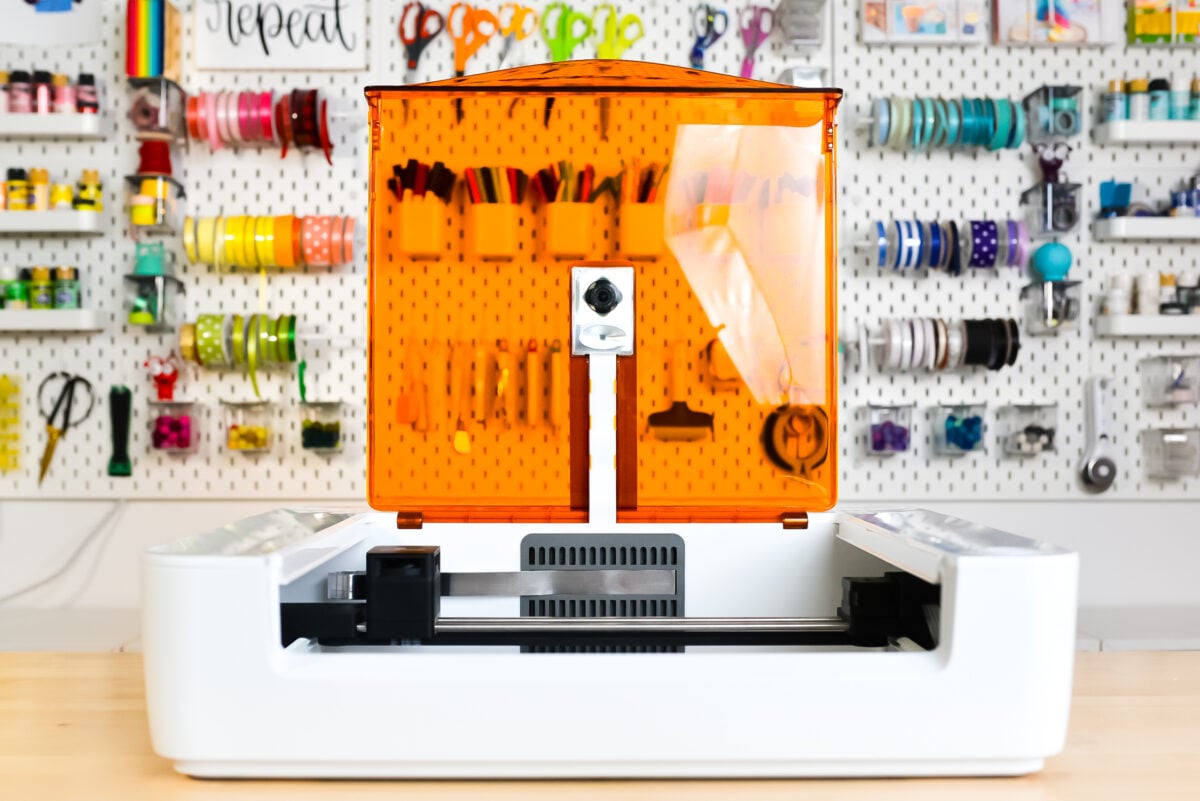
Last year, Glowforge® launched their newest laser Glowforge Aura™. This Craft Laser™ was designed as a more affordable laser for a wider crafting audience. You can read my Review of Glowforge Aura for all the details.
But Glowforge wasn’t done! They are now launching another crafting laser called Glowforge Spark! Glowforge Spark is basically a smaller version of Glowforge Aura at an even lower price point, making it accessible to even more crafters.
In this post, I’m going to share all the details about this small laser machine, including how to use it, how it differs from Glowforge Aura, tips and tricks, and the pros and cons of buying. That way you can make the right choice for your budget and needs!
Watch the Video
Watch my YouTube video where I go into everything in this post! Just click play below, or keep reading for a full tutorial.
What is Glowforge Spark?
Glowforge Spark is a compact laser cutting machine designed to be an entry-level laser for everyday crafters. This machine is a great bridge into laser crafting if you’re an electronic cutting machine (Cricut, Silhouette, etc.) crafter.

Note: Glowforge calls anything you make with your machine a “print,” which may be a bit confusing to new users since there is no actual printing with a printer involved. Just be aware that you’ll see that term used quite a bit.
Because Glowforge Spark uses a laser instead of a blade, you will never experience the drag of a blade, meaning that your printing should always be precise and you can cut and engrave fine details. You can also cut much thicker materials that are impossible to cut with a blade.
AND you can also cut some of the material you can cut on your electronic cutter, like laser-safe iron-on alternatives (Glowforge has their own), cardstock, and fabric.
Who is Glowforge Spark For?
Before we get into all of the specs, let’s talk about who this Craft Laser is for.
- If you are new to the laser crafting world and you want to make small projects, this laser is for you.
- If you are a Cricut or Silhouette crafter and you want to increase the projects you can make, this laser is for you.
- If you don’t have a lot of space but you want to be able to make laser projects, this laser is for you.
- If you don’t have a large budget but you want to try out laser crafting, this laser is for you.
- If you want to start a small business, this laser is probably NOT for you, mostly based on the speed and bed size, as you’ll see.
What Can You Make with Glowforge Spark?
You can make a wide range of projects using the Glowforge Spark, with files from the Glowforge Catalog, files you design yourself, or files purchased or downloaded elsewhere. Here are just a few ideas:
- Earrings and other jewelry
- Ornaments and other holiday decor
- Apparel transfers
- 3D projects
- Engraved pencils
- Photograph frames
- Keychains
- Magnets
- Trays, boxes, and other organization projects
- Wedding decor
- Models and miniatures
- And so much more!
I’ll talk about the materials you can use to make these projects later in this post!
Machine Cost
For a limited pre-release, Glowforge Spark is just $599! This is about half of what Glowforge Aura costs, which is a huge savings and in the budget of many more crafters.
Once the pre-release ends on April 5, Glowforge Spark will retail for $699. This is still an incredible value if you’re looking at dipping your toes into laser crafting.
What is the Glowforge Personal Filter?
In addition to your Glowforge machine, you can get a Glowforge Personal Filter™ so you don’t have to vent out of a window.
The filter pulls all of the fumes and smoke created by the machine into the filter instead of letting it out into your craft space. You can also vent your Glowforge Spark out of a window if you’d like (I actually do this with my Glowforge Pro). Just make sure you are able to seal around the filter so the fumes aren’t coming back through the window.
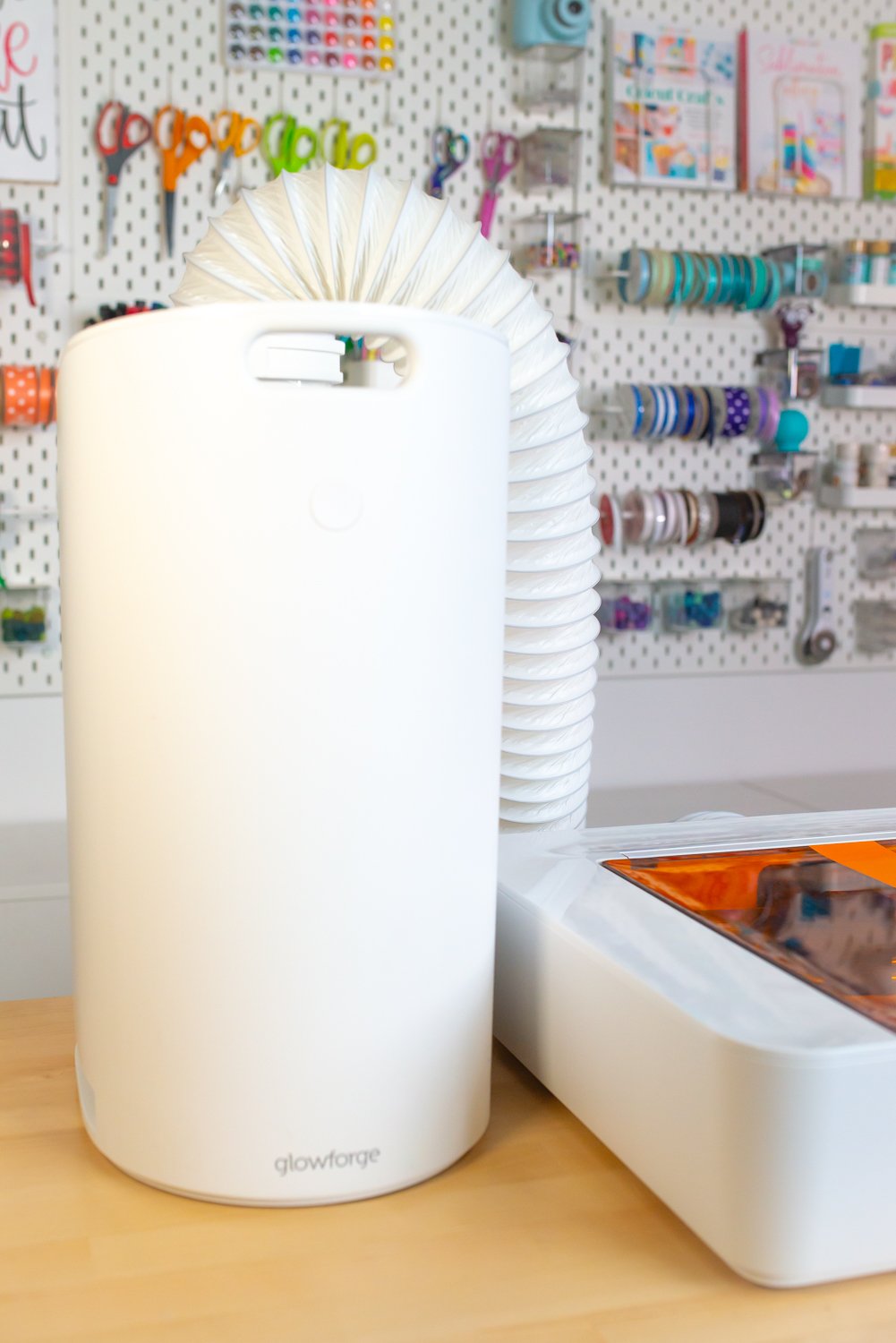
The air filter is WiFi connected to the Spark, which means it turns on automatically when the machine starts cutting and turns off when the project is over. I love this particular feature because filtering a laser cutter is not exactly quiet, and I love that the filter shuts off after the cut instead of continuing to run.
While it’s an extra expense, I really like the filter. It means I don’t have to keep my Glowforge Spark by a window and I think it does a great job of keeping the smoke smell down while I’m running the machine.
The personal filter is $399.
Diode Lasers
Glowforge Spark is a diode laser, vs. a CO2 laser like Glowforge Plus or Glowforge Pro. You can read more about the difference in my Glowforge Aura post, but I’ll give you a quick overview here because it may help make a buying decision easier.
Diode lasers:
- Are economical and lower priced, making them perfect for hobbyists and everyday crafters.
- Have a longer lifespan than CO2 lasers
- Are less powerful than CO2 lasers. Glowforge Spark is a 6W laser whereas my Glowforge Pro is a 45W laser.
- Can be significantly slower than CO2 lasers and may require more passes at slower speeds to cut and engrave certain materials.
- May be less precise than a CO2 laser, though I found Glowforge Spark to be accurate enough for every project I’ve done so far.
- Cut a variety of opaque acrylic colors, but aren’t able to cut clear, translucent, white, or most variations of blue. If you want to cut primarily acrylic, I suggest saving up for a CO2 laser or taking advantage of the monthly financing Glowforge offers on the Glowforge Plus and Pro.
Glowforge Spark Set Up
The box is packed really well, but still use caution when opening it.
Here’s what you’ll find inside:
- Glowforge Spark
- A box with the metal crumb tray and a piece of basswood to practice on
- The vent pipe
- The power cord
Carefully remove the laser head from the foam packaging (be careful, it’s attached to the back of the machine with a ribbon cable) and it will snap into place onto the rails with a magnet. Add the crumb tray to the bottom and you’re ready to go! Set up really is that easy.
Head to setup.glowforge.com for all of the instructions for getting your machine up and running!
Size and Dimensions
The Spark was actually smaller and lighter than I expected! My Glowforge Pro is really heavy, but I was easily able to lift and place the Spark on my table—it weighs around 11 pounds.
It’s about 21.25″ wide and 17.75″ inches deep, but you will need some extra space in the back for the vent pipe (at least 6″). It’s about 5″ tall, but you will also need another 15″ or so above the machine to open the lid and place your materials.
Anatomy of the Machine
Now let’s look at the actual machine itself. The simple white enclosure has an empty bed where you’ll place your materials.
In the bed there’s a silver crumb tray. This removable tray both adds air circulation underneath the material while cutting and allows the small pieces from your project (the “crumbs”) to fall through. You can lift up the tray and remove the crumbs using a handheld vacuum.
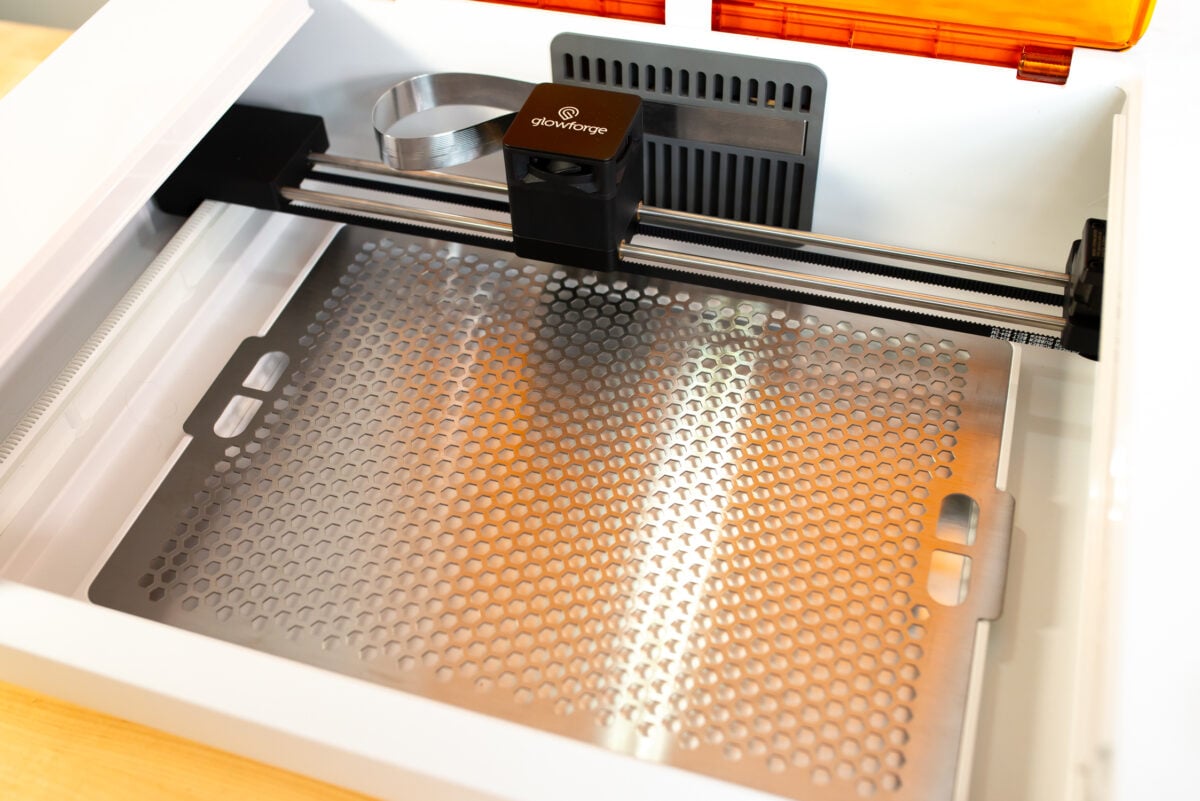
The lid is tinted orange like a welder’s helmet, so you won’t damage your eyes when looking at the laser cutting and engraving.
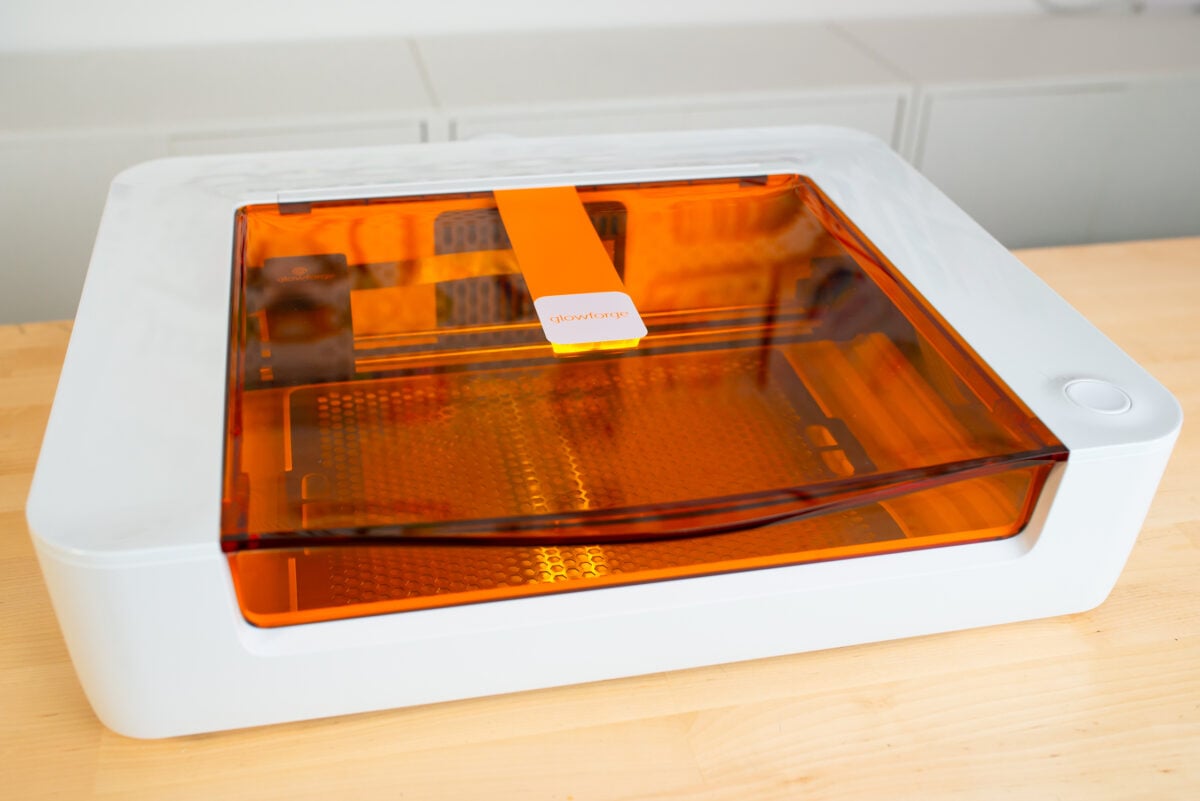
In the lid there is an 8MP camera. This camera takes a photo of your material, allowing you to easily line up your materials and images before printing your project.
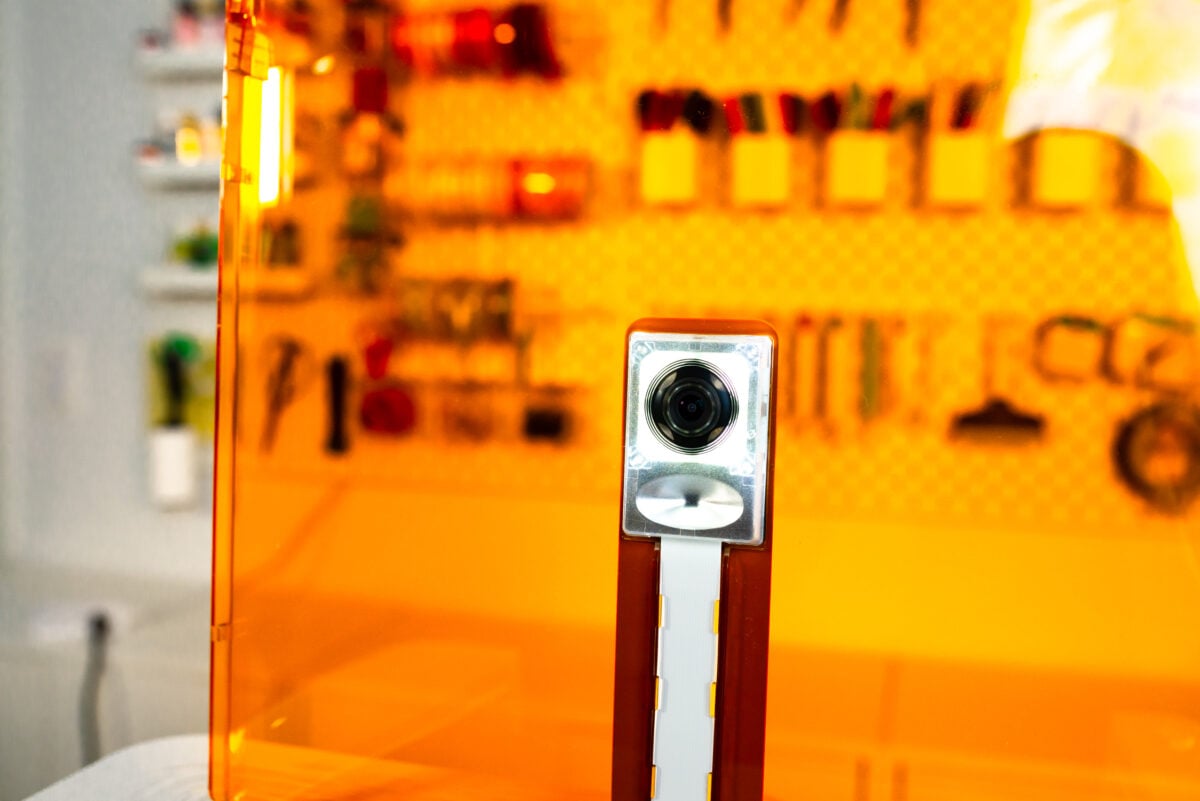
The laser module sits on metal bars that span the width of the machine, and is attached to the machine by a silver ribbon cable. These metal bars move the module back and forth while it’s completing your project.
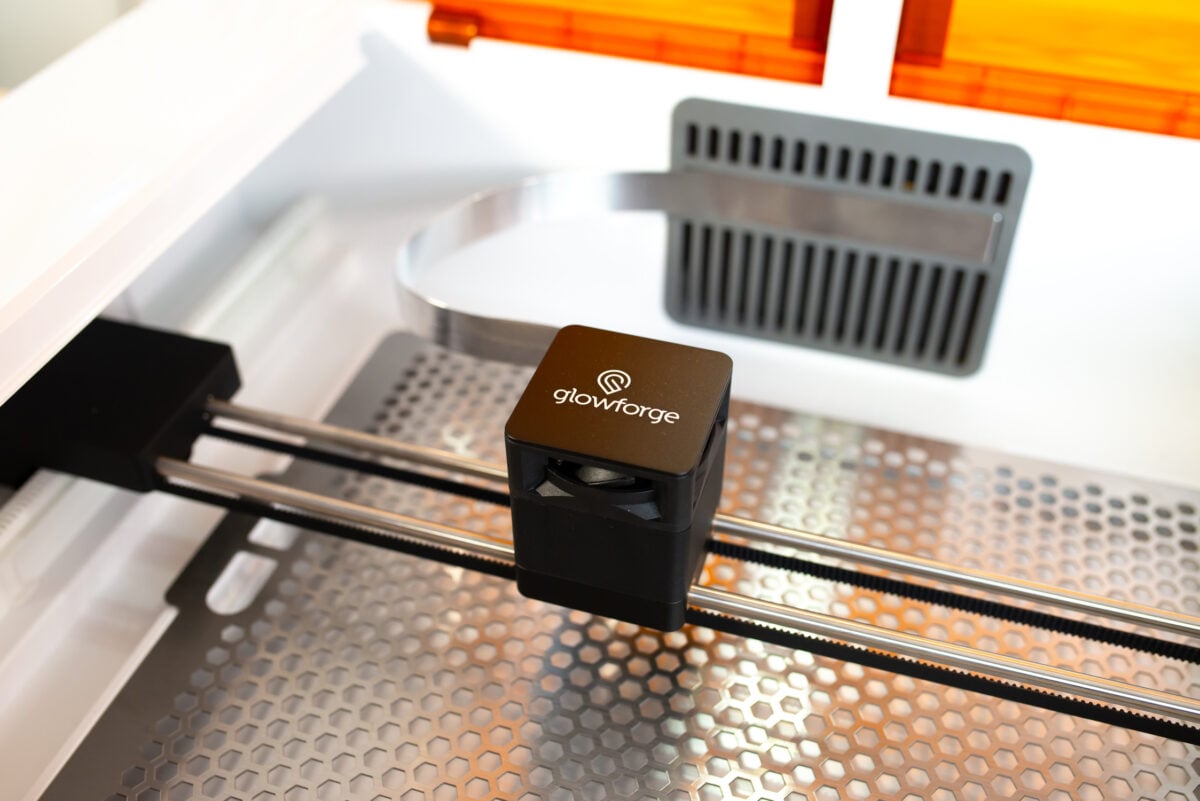
On the outside, there is a single button on the top, which you’ll press to start the machine. Note there is no power button on Glowforge Spark. You just plug the machine in and it turns on. After a period of inactivity, the machine will go to sleep.
Then on the back is the vent, which is where you’ll connect the vent pipe. Remember, you’ll need to vent your Spark out a window or into the personal filter.
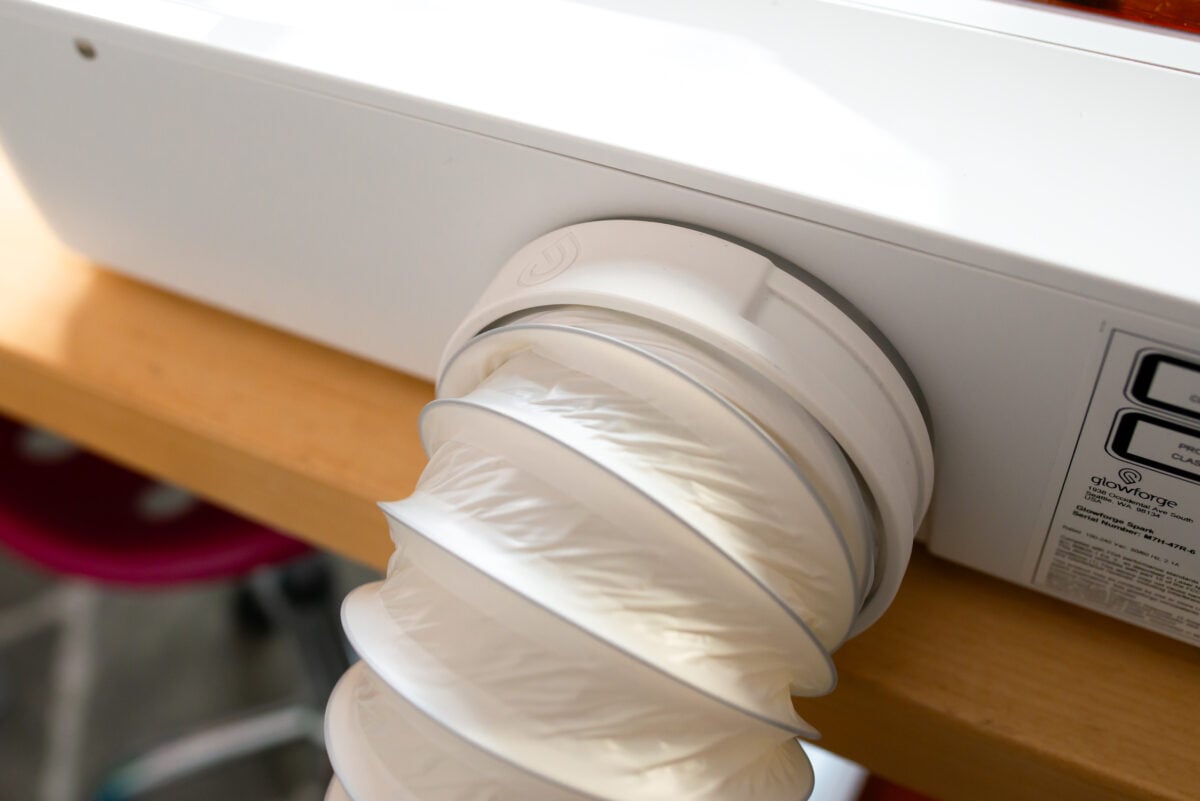
Glowforge Spark Material Sizes
Materials can be up to 8.5″ deep (from the front of the machine to the back) and 11.5″ wide. Glowforge is releasing a new line of 8″ x 12″ materials specifically for this machine.
Materials can be up to 1/4″ thick when using the crumb tray, or up to 3/4″ thick if using it with the crumb tray removed (for engraving only).
Other standard material sizes are a bit odd. The smaller 6″ x 12″ fits pretty well and you can shift the material left and right to start your cuts in the corner.
The 12″ x 12″ can fit, and you can shift it around in the bed but it’s impossible to cut the corners on a 12″ x 12″. piece. But you can cut a 12″ x 12″ piece in half using a straight line, so you can easily cut the material down to be able to use all of it.
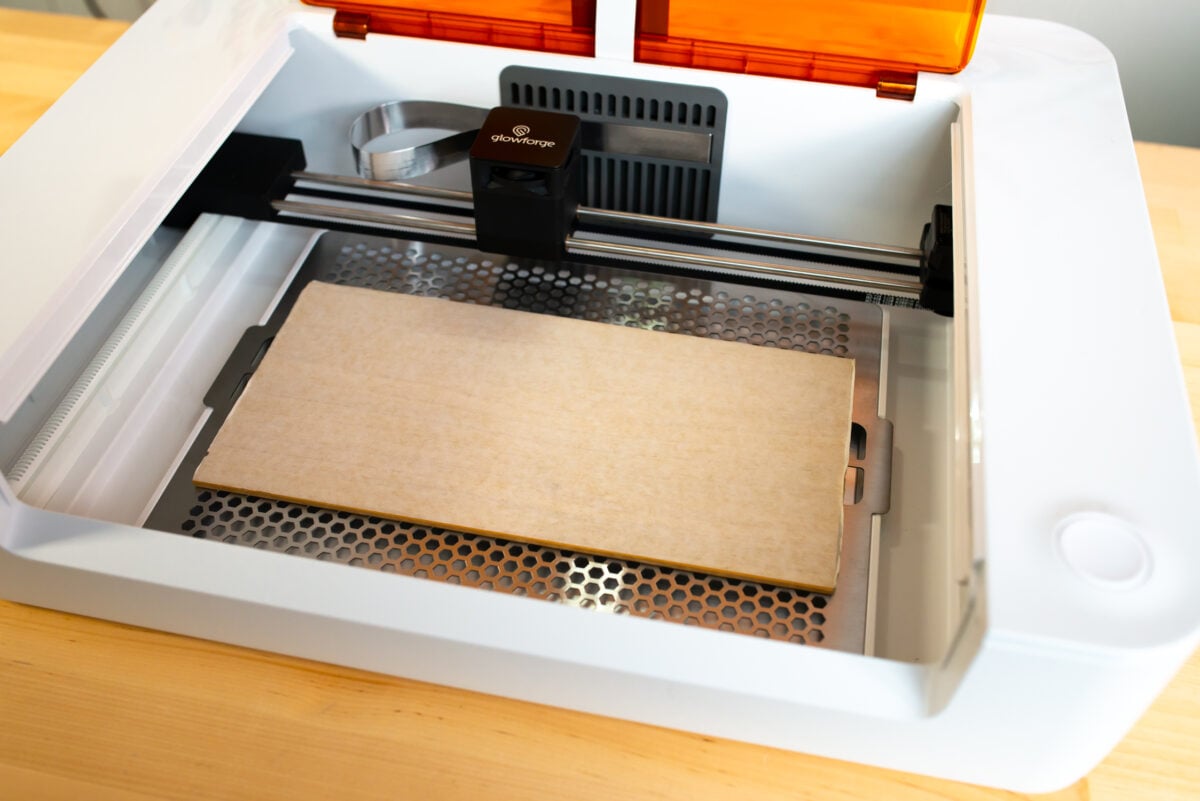
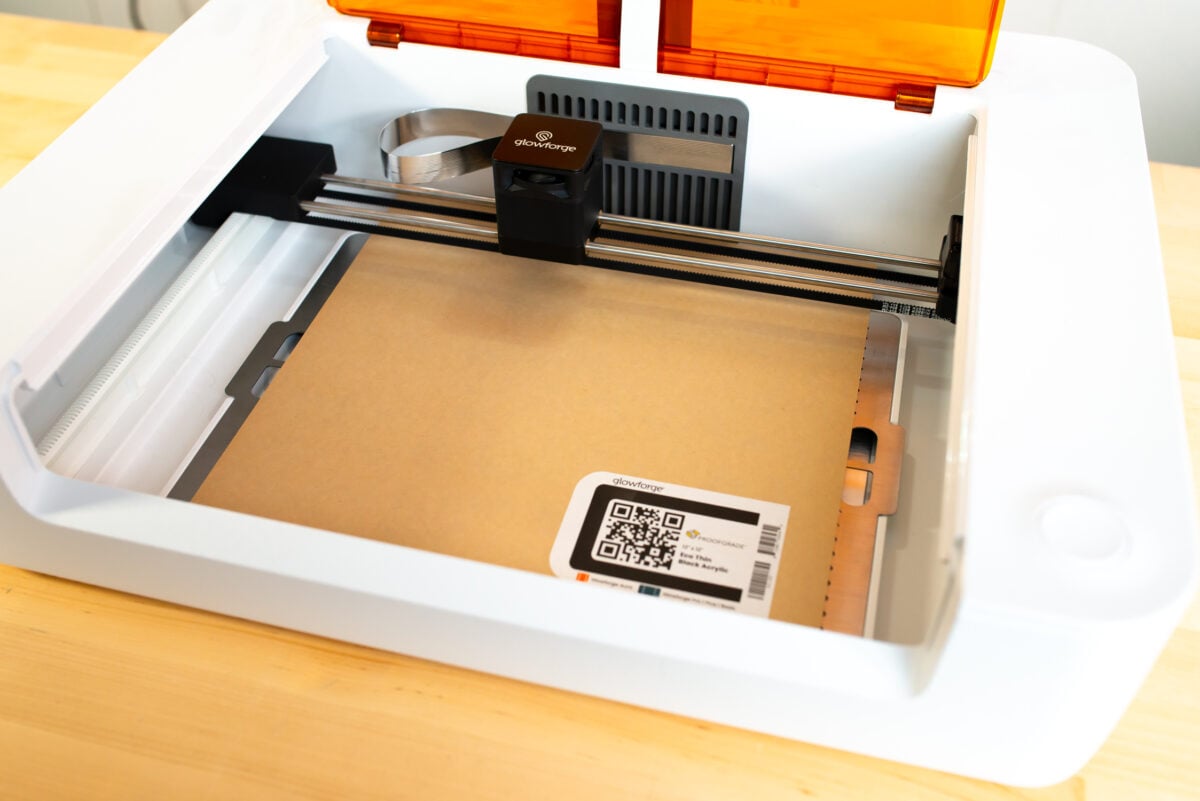
How Loud is the Spark?
Glowforge Spark does makes some sound while running, but it’s not bad at all. The filter is louder, pulling all of the fumes and soot into the bin. It’s nice that the air filter turns off automatically when your project is finished, so it’s not running when you don’t need it.
Glowforge Spark Materials
Proofgrade Materials
When Glowforge launched the Glowforge Aura, they came out with new Proofgrade materials that work really well with these lower wattage lasers. Proofgrade materials have been tested with the machine and have presets within the Glowforge App. They are particularly great for beginners or for users that don’t want to spend time figuring out their settings manually.
Here’s what I received and I’ve tested:
- Light walnut, basswood, cherry, and maple plywood
- Medium walnut and basswood plywood
- Walnut, cherry, and maple veneer
- Thin acrylic in red, green, teal, purple, and black
- Glowforge heat transfer vinyl alternative in a variety of colors
- Thin natural leather
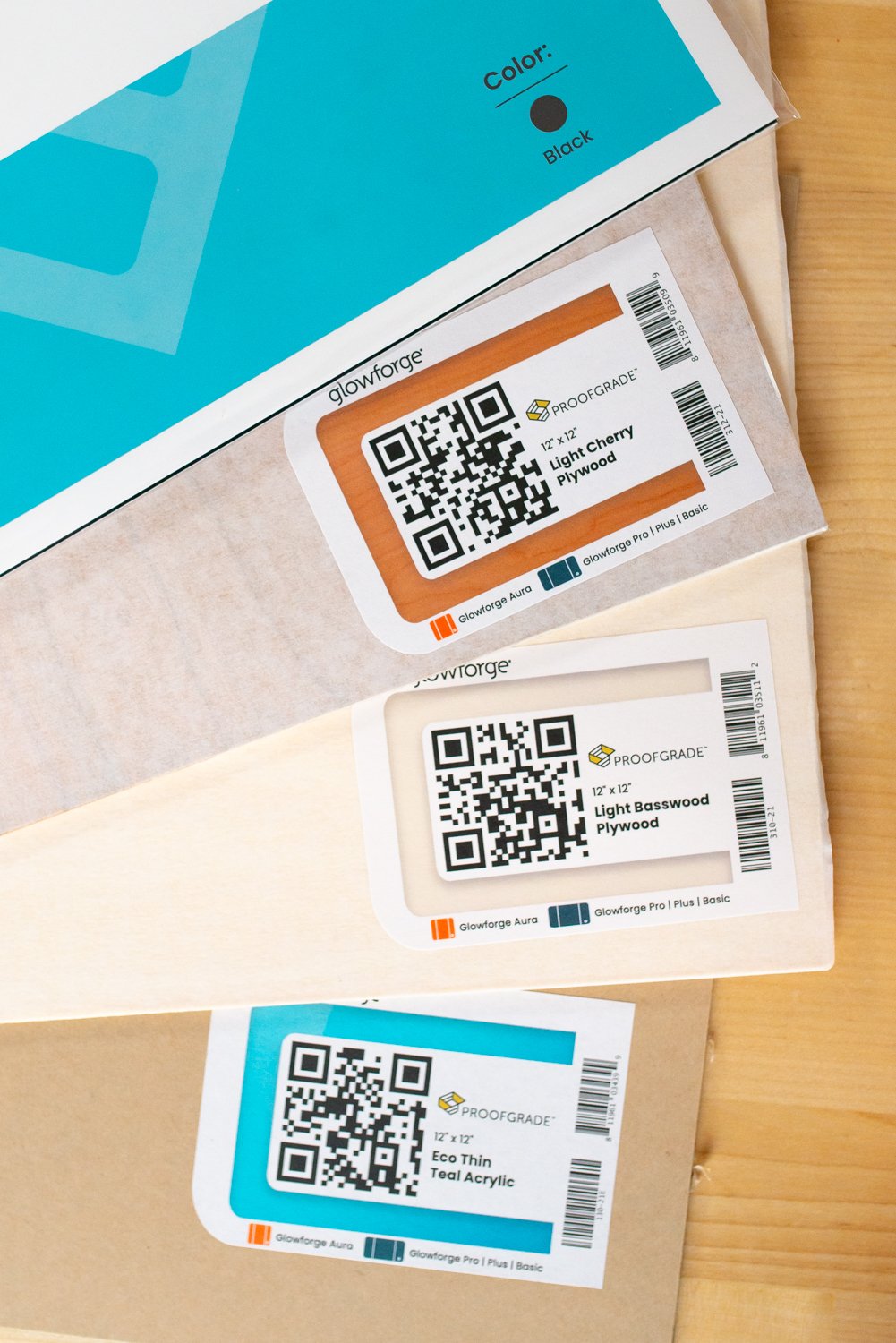
All of these materials cut really nicely with the settings in the Glowforge App.
While you can work with the 6″ x 12″ and 12″ x 12″ material sizes, Glowforge is also releasing a 8″ x 12″ material size that will work perfectly in this machine.
You can also cut your 12″ x 12″ materials in half from left to right to create two 6″ x 12″ pieces to maximize material use!
Non-Proofgrade Materials
Of course you may want to use other non-Proofgrade materials in your Spark, and this will require some testing. Usually I’ll pick the closest Proofgrade material and do a bunch of test cuts to try and figure out if I can cut the non-Proofgrade material.
So you can definitely test materials as long as they are laser-safe (see below). If your cut isn’t going all the way through or your engraving isn’t as deep as you’d like, use more power and/or a slower speed. Then track all of your progress in a notebook or spreadsheet.
If you’re going to use non-proofgrade materials, know that it will require testing. My suggestion is using a simple shape to test, like 1″ stars. Start with the recommended cut settings and go from there. Then once you have that dialed in, try your more complex project.
Users are testing new materials all the time—I suggest checking out the Glowforge Community forums if your curious about cutting and engraving results! I have found them incredibly helpful as I’ve gotten started to find perfect settings and help troubleshooting. People in the forums are always willing to provide fast answers to your questions!
Then, when you find settings that work, write them down. That way you won’t have to spend so much time and materials testing when you use the same material in the future.
Materials it Won’t Cut
IMPORTANT: Because you can cut Glowforge’s heat transfer vinyl alternative in the Spark, you may think you’d be able to cut other types of HTV or vinyl as well. But do NOT use these types of products unless they come from Glowforge or are specifically marked as “laser safe.” Glowforge products are vinyl-free, but anything with vinyl will ruin your Glowforge and cause toxic fumes.
Additionally, like I mentioned above, Glowforge Spark can cut a variety of opaque acrylic colors, but aren’t able to cut clear, translucent, white, or most variations of blue. If you want to cut primarily acrylic, I suggest saving up for a CO2 laser or taking advantage of the monthly financing Glowforge offers on the Glowforge Plus and Pro.
Masking Your Materials
A mask is basically a layer of sticky material (often wide rolls of masking tape) that helps prevent burn or char marks on your projects. Glowforge Proofgrade materials come pre-masked, which is a time saver. I also have a full tutorial on how to mask your laser materials.
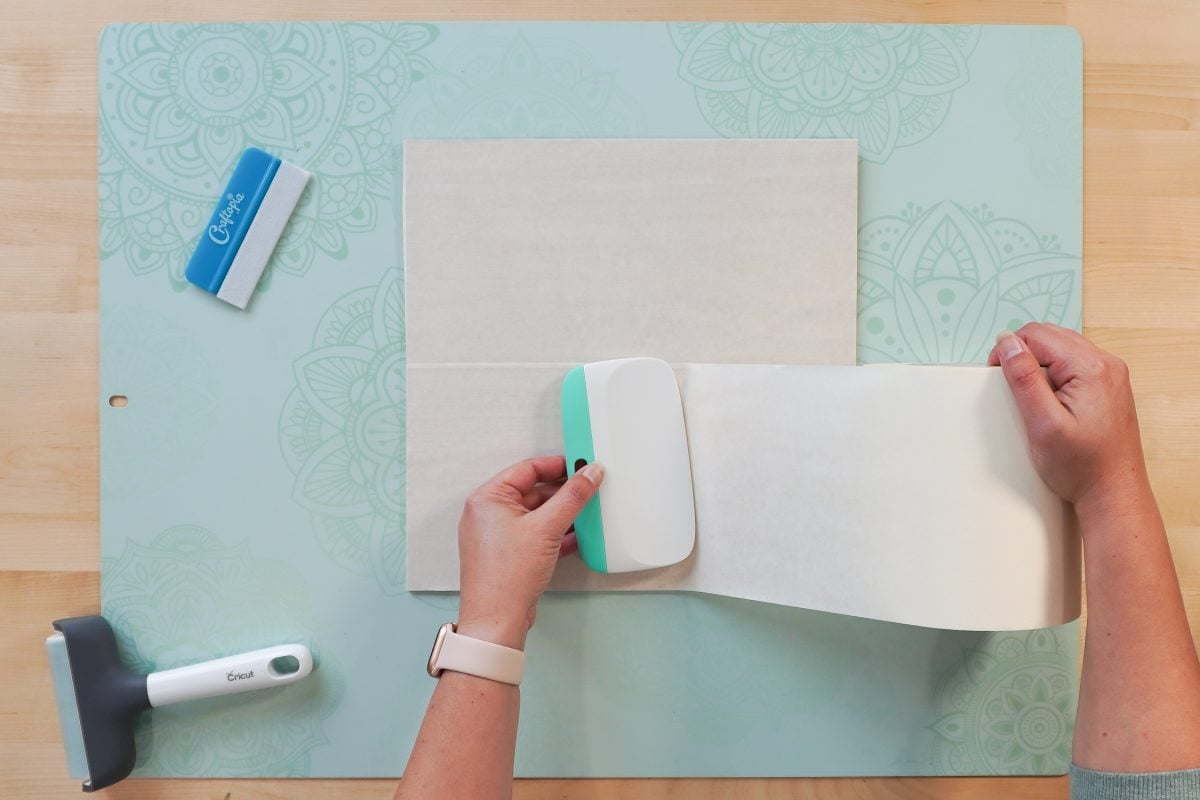
Because the diode laser has so much less power, there may be materials that do not require masking. Again, it’s something you can test!
How is Glowforge Spark different than Glowforge Aura
The two machines are definitely more alike than they are different! Let’s talk about the two biggest differences.
Size
The first is the size of the materials you can use. Instead of 12″ x 12″ materials, you can cut 8.5″ x 11″. This does limit the size of some projects you can make, but overall it’s still a good size for a wide variety of projects, especially for beginners.
The overall size of the Glowforge Spark is a but smaller as well, with Glowforge Aura being 21″ deep and the Spark being 17.75″ deep. The Spark may fit on some shelves or narrow countertops better.
Passthrough
Glowforge Aura has a Passthrough, allowing you to make projects that are wider than the bed of the machine. Glowforge Spark, however, doesn’t have this Passthrough. You are limited to the size of the bed. Again, it’s still a good size for many projects.
There are some other small differences in the overall look of the machine, but those two are the big ones!

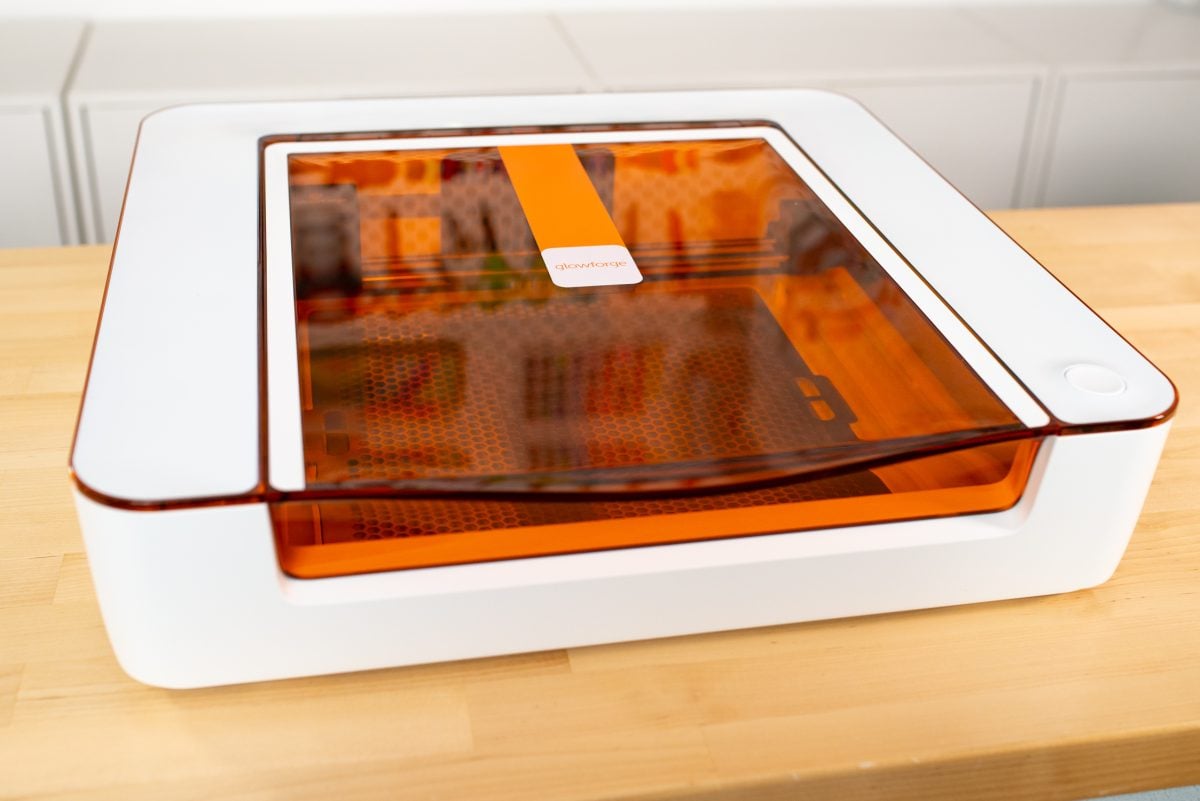
Pros and Cons for Glowforge Spark
There’s been a lot in this post, so I thought I’d talk about some of the pros and cons of Glowforge Spark so you can weigh whether or not this is a good purchase for you.
Pros
- More affordable than a CO2 laser
- More affordable than other diode lasers
- Nice size for hobbyists and crafters
- Small learning curve and easy to use
- Proofgrade materials make dialing in settings easy
- Machine stops when lid is open
- Light and easy to move around
Cons
- Slower cut and engrave speed than a CO2 laser
- Less precision than a CO2 laser
- Can’t cut all acrylic colors or thicker materials
I hope you found this overview of the Glowforge Spark helpful! If this seems like a machine you’d like to own, make sure to grab it while it’s on presale through April 5, 2024 so you can save $100 off the retail price!
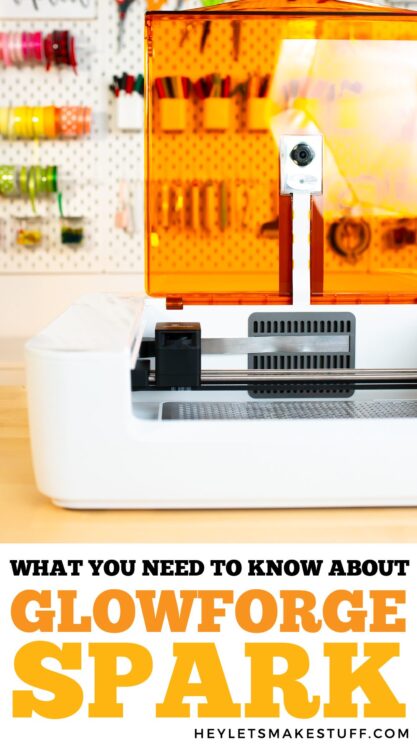

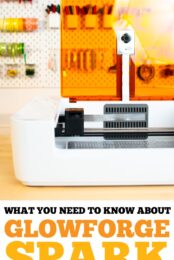


Leave A Reply!